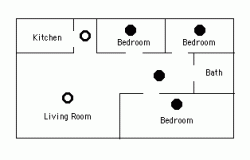 Difference between smoke and CO detectors.
Difference between smoke and CO detectors.
CO detectors do not serve as smoke detectors and vice versa. However, dual smoke/CO detectors are also sold. Smoke detectors detect the smoke generated by flaming or smoldering fires, whereas CO detectors can alarm people about faulty fuel burning devices to prevent carbon monoxide poisoning. Carbon monoxide is produced from incomplete combustion of fossil fuels. In the home CO can be formed, for example, by open flames, space heaters, water heaters, blocked chimneys or running a car inside a garage. Since CO is colorless, tasteless and odorless (unlike smoke from a fire), detection and prevention of carbon monoxide poisoning in a home environment is impossible without such a warning device.
Where should I install the detectors?
Homeowners should remember not to install carbon monoxide detectors directly above or beside fuel-burning appliances, as appliances may emit a small amount of carbon monoxide upon start-up. A detector should not be placed within fifteen feet of heating or cooking appliances or in or near very humid areas such as bathrooms.
When considering where to place a carbon monoxide detector, keep in mind that although carbon monoxide is roughly the same weight as air (carbon monoxide’s specific gravity is 0.9657, where air is 1.0. CO may be contained in warm air coming from combustion appliances such as home heating equipment which could result in the CO rising with the warmer air. So the answer is; follow the manufactures recommendations. For installation requirements for Washington state go to blog post: or consult NFPA 720.
When carbon monoxide detectors were introduced into the market, they had a limited lifespan of 2 years. However technology developments have increased this and many now advertise 5 or even 6 years. Newer models are designed to signal a need to be replaced after that timespan although there are many instances of detectors operating far beyond this point.
Although all home detectors use an audible alarm signal as the primary indicator, some also offer a digital readout of the CO concentration, in parts per million. Typically, they can display both the current reading and a peak reading from memory of the highest level measured over a period of time.
The digital models offer the advantage of being able to observe levels that are below the alarm threshold, learn about levels that may have occurred during an absence, and assess the degree of hazard if the alarm sounds. They may also aid emergency responders in evaluating the level of past or ongoing exposure or danger of carbon monoxide poisoning.
Battery-only carbon monoxide detectors tend to go thru batteries more frequently than expected. Plug-in detectors with a battery backup (for use if the power is interrupted) provide less battery-changing maintenance.

Leave A Comment
You must be logged in to post a comment.